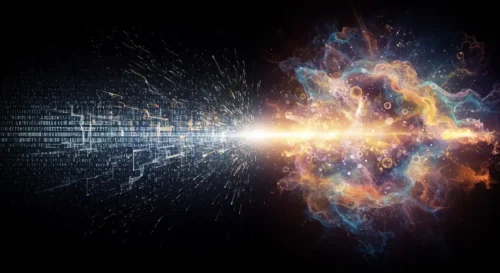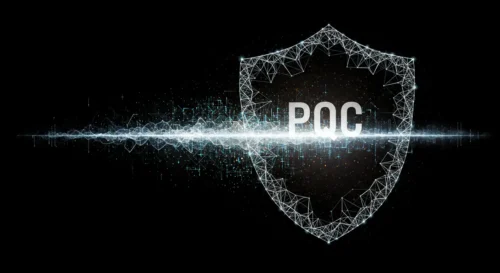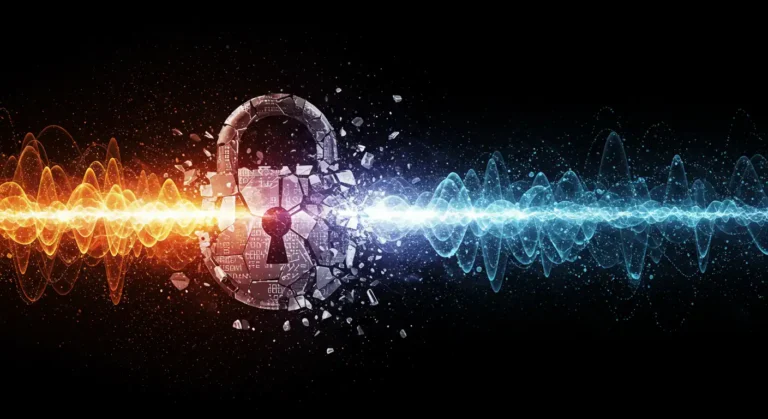The Rise of Quantum Computing and Its Impact on Cybersecurity
I. Introduction:
Imagine a computer that can solve problems currently considered impossible, a machine capable of breaking the most sophisticated encryption algorithms we rely on to protect our digital world. This isn’t science fiction; it’s the potential of quantum computing. A single quantum computer could, in theory, crack the encryption that secures online banking, e-commerce, and even government secrets in a fraction of the time it would take the most powerful supercomputers today. This looming threat to modern cryptography is what makes the rise of quantum computing a critical concern for cybersecurity.
Unlike classical computers, which store information as bits representing either 0 or 1, quantum computers use qubits. Qubits leverage the principles of quantum mechanics, such as superposition and entanglement, to exist in multiple states simultaneously. Superposition allows a qubit to be both 0 and 1 at the same time, significantly increasing the amount of information it can store. Entanglement links two or more qubits together, so that they share the same fate, even when separated by vast distances. These unique properties allow quantum computers to perform certain calculations exponentially faster than classical computers, opening up possibilities for breakthroughs in various fields, but also posing a significant risk to current cryptographic methods.
The development of quantum computers poses a serious threat to the cryptographic systems that underpin modern digital security. However, this challenge has also spurred the development of new and innovative defense mechanisms. This article will explore the growing threat of quantum computing to cybersecurity, delve into the new cryptographic approaches being developed to counter this threat, and discuss what the future holds for digital security in the age of quantum computing.
II. How Quantum Computing Threatens Current Cryptography

Modern cryptography relies on mathematical problems that are easy to compute in one direction but extremely difficult to reverse. These “one-way functions” form the basis of many widely used encryption algorithms, such as RSA and Elliptic Curve Cryptography (ECC). However, the advent of quantum computing poses a significant threat to these cryptographic systems.
Shor’s Algorithm and its Implications:
Peter Shor’s algorithm, developed in 1994, is a quantum algorithm that can efficiently solve two mathematical problems that are crucial to modern cryptography: integer factorization and the discrete logarithm problem. Classical computers struggle with these problems, especially when dealing with very large numbers. This difficulty is what makes algorithms like RSA and ECC secure in the classical computing world.
- Integer Factorization: RSA encryption relies on the difficulty of factoring large composite numbers into their prime factors. For example, it’s easy to multiply two large prime numbers together, but it’s incredibly difficult for a classical computer to determine those prime factors if given only the product. Shor’s algorithm, however, can efficiently find these prime factors on a quantum computer, effectively breaking RSA encryption.
- Discrete Logarithm Problem: ECC relies on the difficulty of solving the discrete logarithm problem over elliptic curves. This problem is also computationally hard for classical computers, but Shor’s algorithm can solve it efficiently on a quantum computer, rendering ECC vulnerable.
Vulnerability of RSA and ECC:
The implications of Shor’s algorithm are profound. Once a sufficiently powerful quantum computer is built, it could easily break RSA and ECC encryption, compromising the security of a vast amount of sensitive data. This includes:
- Online Transactions: Secure online shopping, banking, and other financial transactions rely heavily on RSA and ECC. A quantum computer could decrypt these transactions, exposing credit card numbers, bank account details, and other sensitive financial information.
- Data Protection: Sensitive data stored in databases, cloud storage, and other systems is often encrypted using RSA or ECC. Quantum computers could decrypt this data, exposing personal information, medical records, government secrets, and intellectual property.
- Secure Communications: Secure communication protocols like TLS/SSL, which protect online communication and VPN connections, also rely on RSA and ECC. Quantum computers could intercept and decrypt these communications, compromising privacy and security.
Consequences of Broken Cryptography:
The ability of quantum computers to break current cryptographic systems has far-reaching consequences. It could lead to:
- Financial losses: Massive financial losses due to fraud, theft, and data breaches.
- Privacy breaches: Exposure of personal information, leading to identity theft and other privacy violations.
- National security threats: Compromising government secrets and critical infrastructure.
- Erosion of trust in online systems: Undermining trust in online transactions and digital communication.
The threat posed by quantum computing to current cryptography is not a hypothetical future problem. It’s a real and present concern that requires immediate attention and action. This is why the development of post-quantum cryptography is so critical.
III. Post-Quantum Cryptography (PQC) – The Defense

The threat posed by quantum computers to current cryptographic systems has spurred significant research and development in the field of post-quantum cryptography (PQC), also known as quantum-resistant cryptography. The goal of PQC is to develop cryptographic algorithms that are secure against attacks from both classical and quantum computers. These algorithms are designed to replace the currently used public-key cryptography algorithms, such as RSA and ECC, before large-scale quantum computers become a reality.
Key Approaches in PQC:
Several promising approaches are being explored in the field of PQC, each based on different mathematical problems that are believed to be hard for both classical and quantum computers:
- Lattice-based Cryptography (Ґраткова криптографія): This approach relies on the difficulty of solving certain problems involving mathematical lattices, which are regular arrays of points in space. These problems, such as the shortest vector problem and the closest vector problem, are believed to be computationally hard even for quantum computers. Lattice-based cryptography offers strong security guarantees and is considered one of the most promising PQC candidates.
- Code-based Cryptography (Криптографія на основі кодів): This approach uses error-correcting codes, which are used to detect and correct errors in data transmission. The security of code-based cryptography relies on the difficulty of decoding general linear codes, a problem that is believed to be hard for quantum computers. McEliece cryptosystem is a well-known example of code-based cryptography.
- Multivariate Cryptography (Багатовимірна криптографія): This approach uses systems of multivariate polynomials over finite fields. The security of these systems relies on the difficulty of solving systems of polynomial equations, a problem that is generally considered hard for both classical and quantum computers.
- Isogeny-based Cryptography (Ізогенії еліптичних кривих): This relatively new approach uses isogenies between elliptic curves. An isogeny is a special type of mapping between elliptic curves. The security of isogeny-based cryptography relies on the difficulty of finding isogenies between elliptic curves, a problem that is believed to be hard for quantum computers.
Standardization Efforts (Стандартизація):
The National Institute of Standards and Technology (NIST) has been actively involved in the standardization of PQC algorithms. In 2016, NIST launched a process to solicit, evaluate, and standardize post-quantum cryptographic algorithms. After several rounds of evaluation, NIST announced the first group of selected algorithms in 2022. These algorithms are expected to become the new standards for public-key cryptography in the post-quantum era. The standardization process is crucial for ensuring interoperability and security of PQC implementations.
Importance of Transition:
The transition to PQC is a complex and time-consuming process. It requires significant effort from developers, vendors, and organizations to implement new algorithms and update existing systems. However, this transition is essential to maintain the security of our digital infrastructure in the face of the growing threat of quantum computing. Proactive measures are needed now to ensure that sensitive data remains protected in the future.
IV. Quantum Key Distribution (QKD) – A Different Approach

While post-quantum cryptography focuses on developing new algorithms that are resistant to quantum attacks, Quantum Key Distribution (QKD) takes a completely different approach to secure communication. Instead of relying on complex mathematical problems, QKD leverages the fundamental laws of quantum mechanics to ensure secure key exchange.
How QKD Works:
QKD uses quantum properties, such as the polarization of photons or other quantum states of particles, to transmit cryptographic keys between two parties, traditionally called Alice and Bob. Here’s a simplified explanation of how it works:
- Quantum Transmission: Alice encodes information onto individual photons (or other quantum particles) by manipulating their quantum properties, such as polarization. She then sends these photons to Bob through a quantum channel, typically a fiber optic cable.
- Measurement: Bob measures the incoming photons using detectors. Because of the principles of quantum mechanics, any attempt to intercept or measure the photons by a third party (Eve) will inevitably disturb their quantum state.
- Key Reconciliation: Alice and Bob then communicate over a classical public channel (like the internet) to compare some of their measurement results. They don’t reveal the actual key values, but they compare certain properties of their measurements.
- Error Correction and Privacy Amplification: By comparing their measurements, Alice and Bob can detect any discrepancies that indicate an eavesdropping attempt. If the error rate is below a certain threshold, they proceed with error correction and privacy amplification techniques to distill a secure, shared key.
Advantages of QKD:
The primary advantage of QKD is its theoretical unconditional security. Because any attempt to intercept the key will inevitably disturb the quantum states of the photons, Eve’s presence will be immediately detected. This security is guaranteed by the laws of physics, not by the computational difficulty of mathematical problems. This means that QKD is secure against any future advances in computing technology, including quantum computers.
Limitations of QKD:
Despite its strong security guarantees, QKD has some limitations:
- Distance Limitations: Due to signal loss in fiber optic cables, the distance over which QKD can be implemented is currently limited. Repeaters or quantum repeaters are being developed to extend this range, but they are still under research and development.
- Cost: Implementing QKD systems can be expensive due to the specialized equipment required, such as single-photon sources and detectors.
- Infrastructure: QKD requires dedicated quantum channels, which may not be readily available in all locations. Integrating QKD into existing communication infrastructure can be challenging.
QKD vs. PQC:
It’s important to distinguish between QKD and PQC. QKD focuses on secure key exchange, while PQC focuses on developing new cryptographic algorithms that can be used for encryption, digital signatures, and other cryptographic tasks. These two approaches are not mutually exclusive; they can be used together to provide a comprehensive security solution in the post-quantum era. For example, QKD can be used to securely distribute keys, which can then be used with PQC algorithms for encryption.
V. Conclusion
The rise of quantum computing presents a dual challenge and opportunity for cybersecurity. On one hand, it poses a significant threat to currently used cryptographic algorithms, such as RSA and ECC, which are vulnerable to attacks from sufficiently powerful quantum computers. This vulnerability could have devastating consequences for online transactions, data protection, secure communications, and overall trust in online systems.
On the other hand, the development of quantum computing has spurred innovation in the field of cryptography, leading to the emergence of promising new approaches such as Post-Quantum Cryptography (PQC) and Quantum Key Distribution (QKD). PQC aims to create algorithms resistant to attacks from both classical and quantum computers, while QKD uses the laws of quantum mechanics to ensure secure key exchange.
The transition to the post-quantum era is not a matter of “if” but “when.” Organizations and individuals must begin preparing for this transition now to mitigate the risks associated with quantum attacks. This preparation includes:
- Staying informed: Keeping up-to-date with the latest developments in quantum computing and PQC.
- Assessing vulnerabilities: Identifying systems and data that are most vulnerable to quantum attacks.
- Evaluating PQC and QKD solutions: Exploring and testing different PQC algorithms and QKD implementations.
- Developing migration strategies: Planning and implementing the transition to new cryptographic standards.
By taking proactive steps today, we can ensure a more secure digital future in the age of quantum computing.
VI. Frequently Asked Questions (FAQ)
Here are some frequently asked questions about quantum computing and its impact on cybersecurity:
-
What is a quantum computer?
A quantum computer is a type of computer that uses the principles of quantum mechanics to perform computations. Unlike classical computers, which use bits representing 0 or 1, quantum computers use qubits, which can exist in multiple states simultaneously due to superposition. This allows them to solve certain problems much faster than classical computers.
-
Why are quantum computers a threat to cybersecurity?
Quantum computers can efficiently solve certain mathematical problems that are currently used to secure many cryptographic systems. Specifically, Shor’s algorithm, a quantum algorithm, can break widely used public-key encryption algorithms like RSA and ECC.
-
What is post-quantum cryptography?
Post-quantum cryptography (PQC) refers to cryptographic algorithms that are designed to be secure against attacks from both classical and quantum computers. These algorithms are based on mathematical problems that are believed to be hard for both types of computers.
-
When will quantum computers be able to break current cryptographic systems?
It’s difficult to predict exactly when sufficiently powerful quantum computers will be available. However, experts believe that it’s crucial to begin preparing for this possibility now, as the transition to new cryptographic standards can take many years. It is important to remember that data encrypted today might need to remain secure for many years into the future, and so the threat is present now, even if a quantum computer capable of breaking current systems does not yet exist. This is sometimes called the “harvest now, decrypt later” attack.
-
What can be done now to protect against quantum attacks?
Organizations and individuals can begin by staying informed about the developments in PQC and evaluating potential solutions. They should also assess their systems and data to identify vulnerabilities and develop migration strategies for transitioning to new cryptographic standards when they become available. NIST has already selected several PQC algorithms for standardization, and it is recommended to follow their recommendations.

